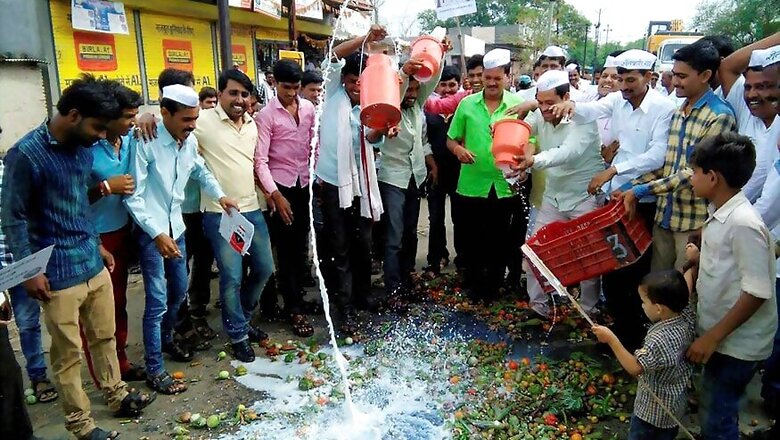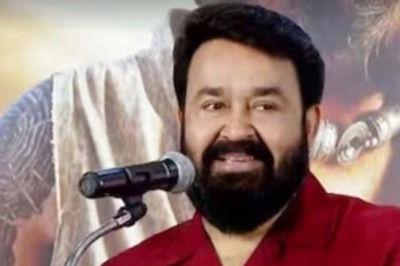
views
Nagpur: The devil is in the detail. And the details aren’t clear when it comes to Devendra Fadnavis-led Maharashtra government’s grand announcement for a farm loan waiver on June 11. In the face of protests by the peasants across the state for 10 days, the announcement helped in restoring peace, but the nature and scope of this decision is not yet clear.
The June 11 agreement between the representatives of farmers and a ministerial group led by Minister of Cooperation Chandrakant Patil had three operative words: that it was “in-principle” (tatvataha) agreed to give a “complete” (sarsakat) loan waiver to the farmers in lieu of certain “criteria” (nikash). As former Union agriculture minister Sharad Pawar quipped while welcoming the decision: “I am curious about those three words.” The entire peasantry of the state is.
We will know the meaning of these words when the committees will deliver their reports whenever they are forked out to determine the extent and nature of the waiver. The government says it wants to target small and marginal farmers, who it terms as real farmers in trouble. It wants to keep out the rich farmers from this scheme. We will know who is poor and who is rich in the official lexicon when details are out.The immediate challenges
Yet, since 2012, nearly 3.5 million farmers — mostly from dryland belts of Marathwada and Vidarbha — have defaulted on loan repayment due to successive years of drought and crop failures.
The unpaid debt is to the tune of Rs 31,000 crore, or almost four times the loans that the Maharashtra farmers had got waived in the 2008 scheme, which was doled out by the UPA-I. We don’t know the private debts of the farmers, and in any case, like in 2008, such loans would remain out of the government’s purview. To that end, any amount of formal loan waivers would not help ease the informal loan burden on farmers.
Fadnavis has bitten the bullet, but must face at least two immediate economic consequences:
Over 3 million farmer households who are the loan-defaulters since 2012 would still have to borrow from private or informal sources. They are being told by the government that their bank loans stand waived with immediate effect as of June 12, 2017 and that they can avail fresh loans.
It will lead not just to confusion but also chaos in a few days when they start queuing up outside the banks for fresh crop loans.
Central public sector banks will say they can’t restructure old unpaid loans without an official order. The order must come from the Centre or the RBI. The Centre says it’s not game for a waiver. The RBI holds that the loan-waivers are financial imprudence. The states may guarantee reimbursement. But when? And how?
Maharashtra’s consolidated debt stands at Rs 4.13 lakh crore. It may borrow more to bear the burden, or cut the plan size and trim the welfare schemes, or do both — there’s little choice.
One committee is expected to study that and recommend ways to raise the money to foot the waiver bill. The other will frame the criteria and work out modalities to deliver the sop.
Unlike the Vidarbha and Marathwada farmers, the peasants in the sugar and horticulture-rich areas of western and north Maharashtra are in trouble since demonetization. The per capita loans there are big. Post-demonetization, when their cash economy got wrecked by recall of old notes, they have been in iffy.
The current turmoil was sparked by the protests led by these farmers in Nashik, Ahmednagar, Pune and sugar-belts of Satara, Sangli, Solapur and Kolhapur.The political decision
Fadnavis won’t enter the economic quagmire unless it brings him big political dividends. Indications are that he might go for fresh polls later this year riding on the loan waiver sop.
The riders – of “criteria” and “in principle” – apart, the agreement did not allow the Congress-NCP and the Shiv Sena to take any benefit for pushing the government for a loan waiver.
The CM and farmers’ representatives, almost all of whom were from a non-Congress, non-NCP dispensation, ensured that there was no room left for the opposition or the ally, Sena, to sneak into the game.
The government ensured that Raju Shetty, Lok Sabha member and leader of Swabhimani Shetkari Sanghatna, hogs the limelight in clinching the deal (Shetty’s small party is an NDA ally); while Shetty and his other comrades managed to keep the narrative firmly amenable to the Fadnavis-government.Old lesson, new waiver
Beyond the immediate political and the economic truth is the bigger, structural challenge though: how do you significantly improve the income of the farmers, particularly in the dry-land belts?
As 2017 proves that 2008 did ease the burden of farmers then, provide momentary relief, and bring down the farm suicides for a year or two, but in the absence of commensurate policies and push for a real impetus to rural economy, neither did the farm suicides abate nor did the vicious indebtedness stop.
The income inequality, going by all reports including the annual economic surveys, has grown sharply between those employed in the service and industrial sector and those languishing at the bottom in the rural areas. To give but one example: Vidarbha — the cotton, soybean and paddy growing eastern region of the state — saw “zero per cent agriculture growth” between 1999-2000 and 2011-12, according to the report of the ‘High Level Committee on Balanced Regional Development issues in Maharashtra’.
That one report is a major explanation to a deepening agrarian distress. “The performance of agriculture in Vidarbha is remarkably lower and depressing when compared to the other regions and even other sectors,” the Committee chaired by well-known economist Dr Vijay Kelkar wrote in one of its chapters. The Report commissioned by the then Prithviraj Chavan government was made public in December 2014 by the Devendra Fadnavis government.


















Comments
0 comment